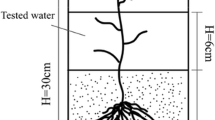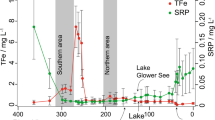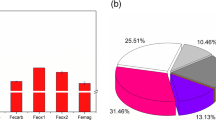Abstract
Purpose
In lake restoration, the redox sensitivity of iron (Fe)–phosphorus (P) compounds has been regarded as detrimental for a sustainable increase in sedimentary P retention since developing low redox potentials release Fe-bound P. Thus, Fe salts alone have rarely been used successfully to inactivate sediment P, and there are no studies on the long-term effects of in-lake Fe applications on P retention. Here, we analyzed for how long, and how efficiently, a single and continuous Fe application can affect the P budget of lakes.
Materials and methods
Two aerated lakes in Berlin, Germany were compared: Lake Tegel (TEG) experienced a continuous Fe supply via its tributaries, while Lake Groß-Glienicke (GGS) was treated once with Fe in the winter of 1992/1993. By controlling the operation of aerators, their effectiveness on P exchange at the sediment–water interface (non-aerated vs. aerated) was directly compared in spring and autumn between 2008 and 2010. The amount of P controllable by aeration (P control) was experimentally determined by non-aerated vs. aerated sediment cores (at 10 and 16 °C). Core stratigraphy of Fe was observed by high-resolution μX-ray fluorescence analysis.
Results and discussion
In TEG, the mobility of Fe was limited due to its sulfidic fixation, and thus Fe only accumulated slightly at the sediment surface (Fe/P ratio, ∼3). P control corresponded to only 4 % of the P content of the lake and 18 % of P loading. Hence, aeration only slightly influenced trophy-relevant epilimnetic P. In GGS, the single Fe application still ensures a high P binding ability of sediment since Fe relocated towards the surface (Fe/P ratio, ∼7). P control corresponded to 38 % of the P content of the lake and 74 % of annual P loading. Thus, the P release is not relevant for the P supply to the epilimnion since with the lake’s overturn P is co-precipitated by the hypolimnetically accumulated Fe.
Conclusions
When external P loading is sufficiently reduced, as in GGS, amendments to Fe precipitants can increase sediment P retention in a redox-dependent manner over the long term. Thus, the redox-dependent mobility of Fe should no longer be regarded as a disadvantage of Fe-containing precipitants. To compensate for co-precipitation and complexation of Fe with sediment organic matter, a high Fe dosage (≥200 g m−2) is needed.






Similar content being viewed by others
References
Amirbahman A, Pearce AR, Bouchard RJ, Norton SA, Kahl JS (2003) Relationship between hypolimnetic phosphorus and iron release from eleven lakes in Maine, USA. Biogeochemistry 65:369–386
Ann Y, Reddy KR, Delfino JJ (2000) Influence of chemical amendments on phosphorus immobilization in soils from a constructed wetland. Ecol Eng 14:157–167
Antelo J, Farce F, Avena M, Fiol S, Lopez R, Macias F (2007) Adsorption of a soil humic acid at the surface of goethite and its competitive interaction with phosphate. Geoderma 138:12–19
Boers P, Van der Does J, Quaak M, Van der Vlugt J (1994) Phosphorus fixation with iron(III)chloride: a new method to combat internal phosphorus loading in shallow lakes? Arch Hydrobiol 129:339–351
Buffle J, DeVitre RR, Perret D, Leppard GG (1989) Physico-chemical characteristics of a colloidal iron phosphate species formed at the oxic–anoxic interface of a eutrophic lake. Geochim Cosmochim Acta 53:399–408
Burley KL, Prepas EE, Chambers PA (2001) Phosphorus release from sediments in hardwater eutrophic lakes: the effects of redox-sensitive and -insensitive chemical treatments. Freshwat Biol 46:1061–1074
Campbell P, Torgersen T (1980) Maintenance of iron meromixis by iron redeposition in a rapidly flushed monimolimnion. Can J Fish Aquat Sci 37:1303–1313
Cooke GD, Welch EB, Martin AB, Fulmer DG, Hyde JB, Schrieve GD (1993) Effectiveness of Al, Ca, and Fe salts to control of internal loading in shallow and deep lakes. Hydrobiologia 253:323–335
Croudace IW, Rindby A, Rothwell RG (2006) ITRAX: description and evaluation of a new X-ray core scanner. In: Rothwell RG (ed) New ways of looking at sediment cores and core data. Geological Society, London, Special Publications 267:51–63
Daldorph P, Price R (1994) Long term phosphorus control at three eutrophic reservoirs in south-eastern England. Arch Hydrobiol Beih Ergebn Limnol 40:231–243
Davison W (1993) Iron and manganese in lakes. Earth Sci Rev 34:119–163
Deppe T, Benndorf J (2002) Phosphorus reduction in a shallow hypereutrophic reservoir by in-lake dosage of ferrous iron. Water Res 36:4525–4534
Friedl G, Wehrli B, Manceau A (1997) Solid phases in the cycling of manganese in eutrophic lakes: new insights from EXAFS spectroscopy. Geochim Cosmochim Acta 61:275–290
Gächter R, Müller B (2003) Why the phosphorus retention of lakes does not necessarily depend on the oxygen supply to the sediment surface. Limnol Oceanogr 48:929–933
Grüneberg B, Kleeberg A (2005) Benthic phosphorus forms and transformations during neutralization of acid mining lakes. In: Serrano L, Golterman HL (eds.) Phosphates in sediments. Proceedings of the 4th International Symposium on Phosphate in Sediments. Backhuys Publishers, The Netherlands, pp. 127–137
Hansen J, Reitzel K, Jensen HS, Andersen FO (2003) Effects of aluminum, iron, oxygen and nitrate additions on phosphorus release from the sediment of a Danish softwater lake. Hydrobiologia 492:139–149
Hupfer M (1995) Bindungsformen und Mobilität des Phosphors in Gewässersedimenten. In: Steinberg C, Bernhardt H, Klapper H (eds) Handbuch Angewandte Limnologie. Kap. IV-3.2. Ecomed, Landsberg am Lech, pp 1–22
Hupfer M (2004) Bedeutung sedimentstratigraphischer Untersuchungen für die Seentherapie. Studia Quaternaria 121:171–178
Hupfer M, Lewandowski J (2008) Oxygen controls the phosphorus release from lake sediments—a long-lasting paradigm in limnology. Int Rev Hydrobiol 93:415–432
Jaeger D (1994) Effects of hypolimnetic water aeration and iron-phosphate precipitation on the trophic level of Lake Krupunder. Hydrobiologia 275(276):433–444
Katsev S, Tsandev I, L’Heureux I, Rancourt DG (2006) Factors controlling long-term phosphorus efflux from lake sediments: exploratory reactive-transport modeling. Chem Geol 234:127–147
Kleeberg A (2002) Phosphorus sedimentation in seasonal anoxic Lake Scharmützel, NE Germany. Hydrobiologia 472:53–65
Lehtoranta J, Ekholm P, Pitkänen H (2009) Coastal eutrophication thresholds: a matter of sediment microbial processes. Ambio 38:303–308
Li YH, Gregory S (1974) Diffusion of ions in sea water and in deep-sea sediments. Geochim Cosmochim Acta 38:703–714
Martynova MV (2010) Iron compound occurrence forms in freshwater deposits: analytical review. Water Resour 37:488–496
Mayer LM, Liotta FP, Norton SA (1982) Hypolimnetic redox and phosphorus cycling in hypereutrophic lake Sebasticook, Maine. Wat Res 16:1189–1196
Murphy J, Riley JP (1962) A modified single solution method for determination of phosphate in natural waters. Anal Chim Acta 27:31–36
Norton SA, Coolidge K, Amirbahman A, Bouchard R, Kopáček J, Reinhardt R (2008) Speciation of Al, Fe, and P in recent sediment from three lakes in Maine, USA. Sci Total Environ 404:276–283
Psenner R, Pucsko R, Sager M (1984) Die Fraktionierung organischer und anorganischer Phosphorverbindungen von Sedimenten–Versuch einer Definition ökologisch wichtiger Fraktionen. Arch Hydrobiol Suppl 70:111–155
Roden EE, Edmonds JW (1997) Phosphate mobilization in iron-rich anaerobic sediments: microbial Fe(III)oxide reduction versus iron-sulfide formation. Arch Hydrobiol 139:347–378
Schauser I, Chorus I (2009) Water and phosphorus mass balance of Lake Tegel and Schlachtensee—a modeling approach. Wat Res 43:1788–1800
Skoog AC, Arias-Esquivel VA (2009) The effect of induced anoxia and reoxygenation on benthic fluxes of organic carbon, phosphate, iron, and manganese. Sci Total Environ 407:6085–6092
Streit B (1994) Encyclopedia of ecotoxicology (Lexikon der Ökotoxikologie). VCH, Weinheim, p 731
Thamdrup B, Fossing H, Jorgensen BB (1994) Manganese, iron, and sulfur cycling in a coastal sediment, Aarhus Bay, Denmark. Geochim Cosmochim Acta 58:5115–5129
Tipping E (1981) The adsorption of aquatic humic substances by iron oxides. Geochim Cosmochim Acta 45:191–199
Tipping E, Thompson DW, Davison W (1984) Oxidation products of Mn(II) in lakes. Chem Geol 44:359–383
Wolter K-D (1994) Restoration of eutrophic lakes by phosphorus precipitation—Lake Gross-Glienicker, Germany. In: Eiseltová M (ed) Restoration of lake ecosystems—a holistic approach. International Waterfowl and Wetlands Research Bureau, Slimbridge, pp 109–118
Zwirnmann E, Krüger A, Gelbrecht J (1999) Analytik im zentralen Chemielabor. Jahresbericht des IGB (Leibniz-Institut für Gewässerökologie und Binnenfischerei) 9:3–24
Acknowledgments
All persons who directly or indirectly contributed to the success of present study are sincerely thanked. Sylvia Jordan, Lisa Seidel, Matthias Tillack, Thomas Rossoll and Bernd Schütze helped in lake sampling. Christiane Herzog, Sarah Schell, Dr Elke Zwirnmann and Hans-Jürgen Exner (all IGB Berlin) performed the chemical analyses. Uwe Heerwagen (AGO Hydroair GmbH, Berlin) guaranteed the technical operation of aerators within the prescribed time limits. Sabine Stahl (Univ. Bremen) conducted the μXRF measurements. Dr Avril Arthur-Göttig (Munich) revised the English. Two anonymous reviewers improved an earlier version of this article by their constructive comments. The study was part of the KLIMZUG ‘INKA BB’ project of the German Federal Ministry of Education and Research (BMBF).
Author information
Authors and Affiliations
Corresponding author
Additional information
Responsible editor: Brian Kronvang
Rights and permissions
About this article
Cite this article
Kleeberg, A., Köhler, A. & Hupfer, M. How effectively does a single or continuous iron supply affect the phosphorus budget of aerated lakes?. J Soils Sediments 12, 1593–1603 (2012). https://doi.org/10.1007/s11368-012-0590-1
Received:
Accepted:
Published:
Issue Date:
DOI: https://doi.org/10.1007/s11368-012-0590-1




